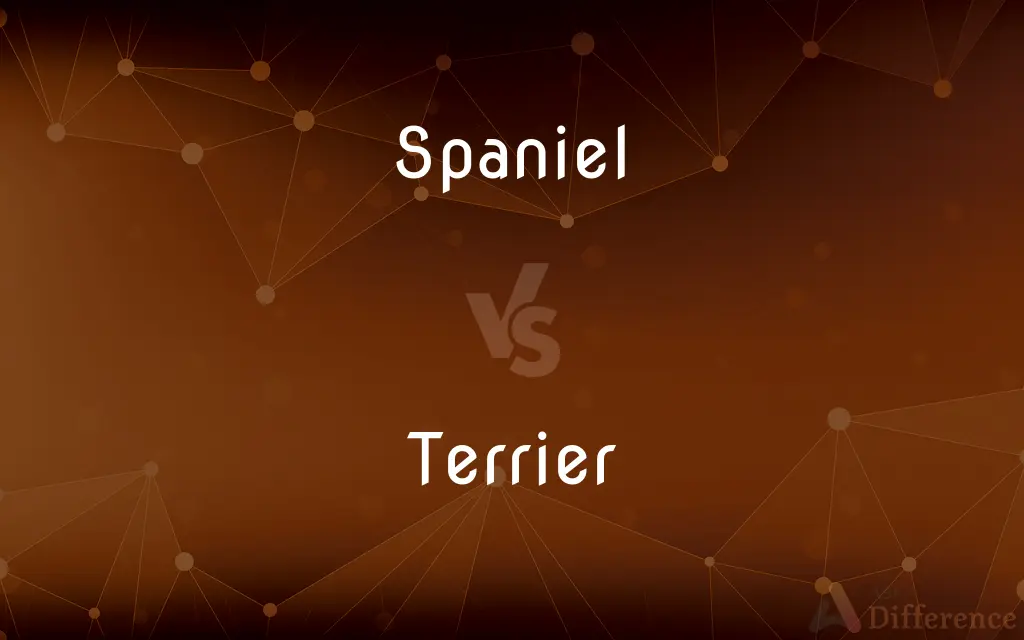Spaniel vs. Terrier — What's the Difference?
By Maham Liaqat & Fiza Rafique — Updated on March 5, 2024
Spaniels are known for their flushing and retrieving abilities in hunting, while terriers excel in vermin control and have a feisty temperament.

Difference Between Spaniel and Terrier
Table of Contents
ADVERTISEMENT
Key Differences
Spaniels are a group of dog breeds originally bred to find and retrieve game from land or water. Characterized by their soft, floppy ears and medium to long coats, spaniels are known for their gentle and affectionate nature. Terriers, on the other hand, are a diverse group of breeds known for their lively and spirited disposition. They were originally bred to hunt and kill vermin, which attributes to their fearless and sometimes stubborn personality.
Spaniels are generally sociable and make excellent family pets, getting along well with children and other dogs. Terriers come in various sizes, but most share common traits such as a wiry coat and a strong, determined character. Despite their small size, terriers are energetic and require plenty of exercise and mental stimulation. They can be great companions but may need firm training due to their strong-willed nature.
Spaniels are often used in hunting scenarios to gently flush game, making them ideal for retrieving birds without damaging them. This soft mouth and instinct to retrieve make them valuable companions for hunters. Their love for water also makes them excellent at water retrieving tasks. Spaniels' friendly demeanor extends beyond the field, as they are adaptable and can thrive in various living conditions as long as they receive enough exercise and companionship.
Terriers, known for their digging and tenacity, excel in activities that mimic their natural instincts, such as earthdog trials. Their history of hunting and controlling vermin has equipped them with a high prey drive, making them excellent watchdogs and lively participants in dog sports that require agility and determination. Terriers often have a strong personality and may exhibit dominance toward other dogs, making early socialization and consistent training crucial for harmonious household integration.
While both spaniels and terriers are energetic and require regular exercise, their differences lie in their historical purposes and resulting temperaments. Spaniels, with their gentle and affectionate nature, are often more adaptable to various family environments. Terriers, with their feisty and independent temperament, may suit active individuals or families who appreciate a spirited companion and are willing to invest time in training and socialization.
ADVERTISEMENT
Comparison Chart
Original Purpose
Flushing and retrieving game
Hunting and killing vermin
Temperament
Gentle, affectionate
Lively, spirited, sometimes stubborn
Physical Traits
Soft, floppy ears, medium to long coats
Wiry coat, varied sizes
Exercise Needs
High, enjoys retrieving and water activities
High, requires mental and physical stimulation
Compatibility
Good with children and other pets
May exhibit dominance, needs socialization
Compare with Definitions
Spaniel
Thrives on activities related to their retrieving instincts.
Daily games of fetch are essential for a spaniel's well-being.
Terrier
A breed group originally bred for hunting vermin.
The Jack Russell Terrier is renowned for its vermin control abilities.
Spaniel
A breed group known for flushing and retrieving game.
The cocker spaniel is often seen retrieving game with a gentle mouth.
Terrier
Benefits from firm, consistent training from an early age.
The terrier responded best to training that included lots of play and rewards.
Spaniel
Adaptable and friendly, making excellent family pets.
The family spaniel bonded closely with all the children.
Terrier
Energetic and fearless, with a noticeable prey drive.
The terrier chased after squirrels with great enthusiasm.
Spaniel
Responsive to training, benefiting from a gentle approach.
The spaniel learned new commands quickly with positive reinforcement.
Terrier
Requires plenty of exercise and mental challenges.
Agility courses are an excellent outlet for a terrier's energy.
Spaniel
Affectionate and sociable with a love for water.
The spaniel joyfully played fetch in the lake for hours.
Terrier
May need monitoring around small pets, strong-willed.
The terrier's bold nature made it the unofficial guardian of the home.
Spaniel
A spaniel is a type of dog. Spaniels were especially bred to flush game out of denser brush.
Terrier
Terrier (from the French word terrier [tɛʁje], meaning "burrow") is a type of dog originally bred to hunt vermin. A terrier is a dog of any one of many breeds or landraces of the terrier type, which are typically small, wiry, game, and fearless.
Spaniel
Any of several breeds of small-sized to medium-sized dogs, usually having drooping ears, short legs, and a wavy, silky coat.
Terrier
A dog of any of various typically small, active breeds originally developed for driving game from burrows.
Terrier
A dog from a group of small, lively breeds, originally bred for the hunting of burrowing prey such as rats, rabbits, foxes, and even otters; this original function is reflected in some of their names (e.g. rat terrier).
Terrier
One of a breed of small dogs, which includes several distinct subbreeds, some of which, such as the Skye terrier and Yorkshire terrier, have long hair and drooping ears, while others, at the English and the black-and-tan terriers, have short, close, smooth hair and upright ears.
Common Curiosities
Are spaniels or terriers better for families?
Both can be great for families, but spaniels may be more adaptable to various environments, whereas terriers might suit active families willing to engage in training.
What are the main differences between spaniels and terriers?
Spaniels are bred for flushing and retrieving game, known for their gentle nature; terriers are bred for hunting vermin, known for their lively temperament.
Which is more suitable for first-time dog owners?
Spaniels might be more suited for first-time owners due to their generally gentler temperament and adaptability.
Can spaniels and terriers get along with other pets?
Spaniels generally get along well with other pets, while terriers may need early socialization due to their high prey drive.
Can either spaniels or terriers live in apartments?
Both can adapt to apartment living if they receive adequate exercise, but their energy levels and exercise needs should be considered.
How do spaniels and terriers differ in training needs?
Spaniels respond well to gentle training methods, while terriers may require more firm and consistent training due to their independent nature.
Are terriers good with children?
Terriers can be good with children if properly socialized and trained, but their energetic nature may require supervision.
Are spaniels good for hunting?
Yes, spaniels excel in hunting roles, particularly in flushing and retrieving game.
Which breed group requires more exercise?
Both require high levels of exercise, but terriers also need mental stimulation to satisfy their hunting instincts.
Do spaniels or terriers have higher grooming needs?
Spaniels may require more frequent grooming due to their longer coats, whereas terriers often have wiry coats that need less frequent care.
How can potential owners decide between a spaniel and a terrier?
Potential owners should consider their lifestyle, the dog's exercise needs, and the time they can devote to training and socialization when deciding between the two.
What kind of health issues are common in spaniels?
Spaniels may be prone to ear infections due to their floppy ears and genetic health issues like hip dysplasia.
Can terriers participate in dog sports?
Yes, terriers excel in dog sports like agility and earthdog trials, which cater to their energetic and tenacious nature.
Do terriers make good watchdogs?
Yes, terriers make excellent watchdogs due to their alert and spirited nature.
What health issues are terriers prone to?
Terriers may be prone to dental issues due to their small jaws and other breed-specific health concerns.
Share Your Discovery

Previous Comparison
Respit vs. Respite
Next Comparison
Fuzz vs. FussAuthor Spotlight
Written by
Maham LiaqatCo-written by
Fiza RafiqueFiza Rafique is a skilled content writer at AskDifference.com, where she meticulously refines and enhances written pieces. Drawing from her vast editorial expertise, Fiza ensures clarity, accuracy, and precision in every article. Passionate about language, she continually seeks to elevate the quality of content for readers worldwide.














































